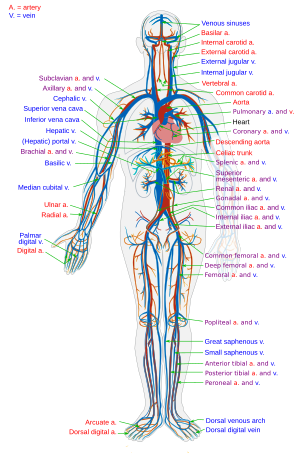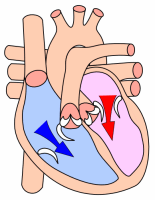Muscular System
1. Total Number of muscles in human body are 636.
2. Study of muscles is called Mycology.
3. Voluntary muscles are striped and are not independent. They are controlled by Spinal cord.
4. Involuntary muscles are smooth. They are concerned with the survival of the animal. They are controlled by autonomic nervous system.
5. Cardiac muscles are involuntary muscles but striped.
6. Muscles convert chemical energy ( glucose) into mechanical energy. In humans this conversion efficiency is 25%.
7. Muscle fatigue is the accumulation of lactic acid.
Transport System
8. Transportation in plants takes place through xylem and phloem tissues.
9. Loss of water through evaporation from plant body is called Traspiration
Human Circulatory System
 Image via Wikipedia
Image via Wikipedia10. In human, heart pumps blood into arteries.
 Image viaWikipedia
Image viaWikipedia11. The aorta is the longest and largest artery in the body.
12. The pulmonary artery is the only artery that contains impure blood and carries it from right Ventricle to the lungs.
13. All veins except pulmonary veins carry impure that is deoxygenated blood.
14. The heart-beat consists of 2 phases systole and diastole.
15. In human adults at rest, the heart beats at the rate of 72 times per minute.
16. Blood pressure is 120mm of mercury in Systole and 80 mm of mercury in diastole.
17. The difference between systolic and diastolic pressure is called pulse pressure.
Blood
18. In adult man normally 5.6 liters of blood is formed.
19. The pH of blood is 7.4,
20. Mixture of RBC, WBC and platelets are there is plazma.
21. RBCs or Erythrocytes are round, biconcave and non-nucleated.
 Image viaWikipedia
Image viaWikipedia22. There are 4 to 6 m RBC/cubic ml of blood.
23. Life of RBC is 120 days.
24. They are formed in red bone marrow of short bones.
25. These are destroyed in liver Spleen.
26. Contain a protein called Haemoglobin which gives them red color.
27. People living in hilly areas have higher number of RBSc than persons living in plains.
No comments:
Post a Comment